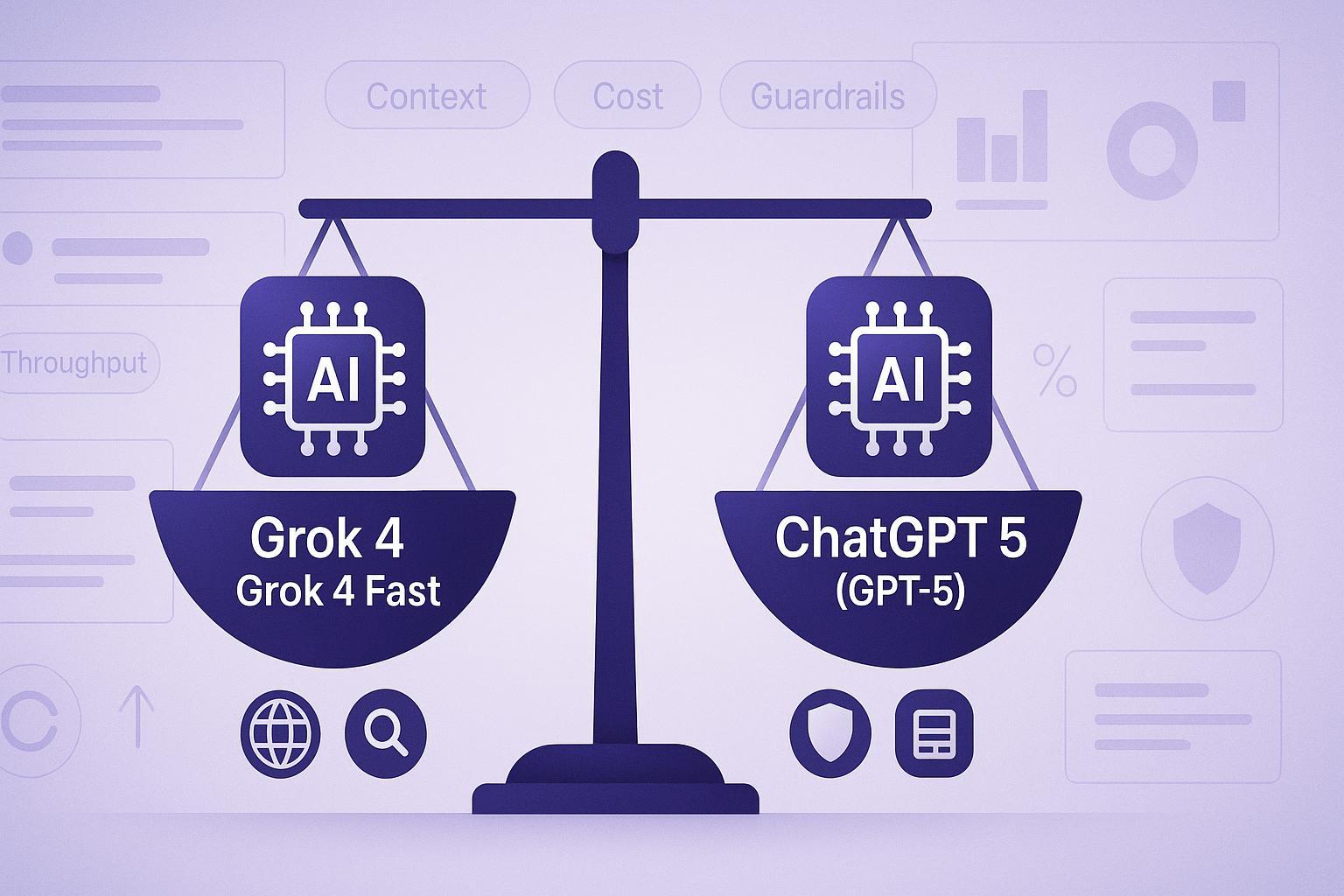Grok 4 vs ChatGPT 5 (2025): Which model fits SEO research and content at SMB scale?

Choosing between xAI’s Grok 4 family and OpenAI’s GPT-5 family isn’t about crowning a single winner—it’s about matching each model to the job. For growth-focused SMB marketers and technical SEOs, the trade-off tends to be: Grok 4 Fast for massive-context, browsing-heavy research at low cost; GPT-5 for brand-safe polish, stricter tone control, and app/memory features. All facts and prices below are as of October 2025.
Quick spec snapshot (what actually affects your workflows)
Context window
Grok 4: 256k tokens officially, with native tool use and real-time search noted by xAI.
Grok 4 Fast: widely cited at up to 2M tokens via aggregator/provider listings.
GPT-5: OpenAI markets up to 400k context with a 128k max output; practical API input caps can be lower depending on surface.
Browsing and tool use
Grok 4/Fast: native tool use and strong live web/X search positioning.
GPT-5: mature tool calling, structured outputs, and agentic workflows via Apps/SDK.
Pricing (per 1M tokens)
Grok 4 Fast: commonly listed around $0.20 input / $0.50 output; higher rates above ~128k context by provider.
Grok 4: around $3 input / $15 output; cached input discounted.
GPT-5: around $1.25 input / $10 output; cached input discounted on Azure.
Enterprise availability
Grok 4: available in Azure AI Foundry.
GPT-5: available via OpenAI API and Azure OpenAI Service; powers ChatGPT tiers and SDKs.
Evidence anchors: xAI’s Grok 4 model page details 256k context and pricing, with native tools and search highlighted in the Grok 4 news post; Grok 4 Fast’s 2M context and low pricing are consistently shown on provider listings alongside xAI’s Fast announcement; GPT-5’s 400k/128k and developer pricing/features are on OpenAI pages; Azure blogs/pricing corroborate enterprise posture and cached input pricing.
xAI Grok 4 model page (256k, pricing): Grok 4 official docs
xAI Grok 4 Fast announcement (40% fewer thinking tokens; availability): Grok 4 Fast (2025) news
Grok 4 Fast availability and 2M context: OpenRouter Grok 4 Fast
Grok 4 enterprise availability: Microsoft Azure blog: Grok 4 in Azure AI Foundry (2025)
GPT-5 pricing/features (developers): OpenAI “Introducing GPT-5 for developers” (2025)
GPT-5 context/output caps: OpenAI GPT-5 landing (400k context; 128k output)
GPT-5 cached input on Azure: Azure OpenAI Service pricing
Best-for scenarios: who should pick which—and why
1) Long-context, browsing-heavy research (SERP + 50–150 sources)
Why Grok 4 Fast often wins
Extremely large working memory (commonly cited up to 2M tokens) helps aggregate source snippets without aggressive chunking.
Low per-token pricing makes frequent browse/tool calls and broad sweeps affordable.
What to watch
Confirm provider-side pricing once you cross ~128k context. Many bill higher above that threshold.
Rate limits vary by provider/tier—batch requests and cache source excerpts to avoid retries.
Setup tip
Use a consistent note schema for source excerpts (URL, title, snippet, date). Ask the model to synthesize contradictions, gaps, and freshness flags before outlining.
2) Brand-safe polish, tone control, and compliance
Why GPT-5 often wins
Stronger guardrails and steerability result in more consistent on-brand copy, which matters for regulated or conservative brands.
Apps/SDK and memory features help standardize tone and reduce rework across a content series.
What to watch
Token costs are higher, especially for long outputs. Reserve GPT-5 for high-value pages where polish and safety pay back.
Setup tip
Use a style/tone contract and a quality checklist that covers factuality, claims, and disclosures. For a structured E-E-A-T pass, see this brief explainer of an E-E-A-T content quality score.
3) Quality per dollar on briefs/outlines at scale
Why Grok 4 Fast often wins
Tool-use RL and efficient “thinking token” behavior make it cost-effective for bulk outlines and FAQ synthesis.
What to watch
If the brief includes many long quotes, deduplicate and compress notes to keep input tokens lean.
Setup tip
Run multi-source clustering first, then ask for a consolidated outline with source citations and a gap analysis.
4) Latency and throughput for teams
Nuanced take
Both families can be fast, but throughput at team scale depends more on rate limits, batching, and caching.
Grok 4 Fast’s low cost encourages parallelism; GPT-5 Apps/SDK enable orchestration across tools.
Setup tip
Batch briefs overnight; reserve a morning window for human QA and GPT-5 polish to keep SLAs predictable.
5) Integrations and enterprise posture
When GPT-5 has the edge
Deep integration with OpenAI Apps/SDK and availability in Azure OpenAI Service; easy tie-ins with Microsoft ecosystems.
When Grok 4/Grok 4 Fast fit
API access via xAI and providers like OpenRouter; Grok 4’s presence in Azure AI Foundry signals enterprise readiness if you prefer the Microsoft stack.
A pragmatic SMB workflow: research with Grok 4 Fast, polish with GPT-5
Here’s a sequential model transfer (SMT) playbook that keeps costs down while preserving quality and safety.
Keyword clustering and SERP synthesis (Grok 4 Fast)
Inputs: seed keywords + top SERP snippets and headings per keyword.
Ask for: clusters, intent labels, and a competitor angle map. If you need a refresher on on-page fundamentals and brief anatomy, skim this SEO cheat sheet.
Outline and FAQ synthesis from 20–100 sources (Grok 4 Fast)
Inputs: source notes with URLs, dates, and 1–3 key claims each.
Ask for: a hierarchical outline, FAQs, citations list, and a “what we won’t claim” section.
First draft with schema hints (pick per page value)
Cost-oriented pages: draft with Grok 4 Fast to save tokens.
Mission-critical pages: draft with GPT-5 for tighter steerability and safer phrasing.
E-E-A-T scoring, tone alignment, on-page polish (GPT-5)
Inputs: brand style guide, claims to verify, and page metadata fields.
Ask for: a scored E-E-A-T pass, suggested edits, and clean metadata (Title/Description/H1/H2s). For metadata fundamentals, see this short guide to TDK for SEO metadata.
Refreshes and fact updates (Grok 4 Fast)
Inputs: change log of facts, new sources, and “must-update” entities.
Ask for: delta edits only, with in-text update notes and a refreshed citations list.
Programmatic SEO at scale (Grok 4 Fast → GPT-5 QA)
Generate many variants cheaply, then use GPT-5 to spot-check tone, PII risks, and compliance on a sampled subset. For broader automation ideas, review this content automation guide.
Token-cost illustrations (order-of-magnitude math)
These examples are illustrative; your actual spend will vary with chunking, caching, and provider.
Research-heavy brief (100k input tokens of source notes; 6k output tokens)
Grok 4 Fast: Input ~$0.02; Output ~$0.003 → Roughly $0.02–$0.03 per brief (under ~128k context). Prices may rise if a single request exceeds provider thresholds.
GPT-5: Input ~$0.125; Output ~$0.06 → Roughly $0.19 per brief.
2,200-word draft + metadata (~6–8k output; ~5k input)
Grok 4 Fast: Output ~$0.003–$0.004; Input ~$0.001 → Around $0.01 per draft.
GPT-5: Output ~$0.06–$0.08; Input ~$0.006 → Around $0.07–$0.09 per draft.
Caveats
If your prompt plus sources exceed ~128k, some providers raise per-token rates or require batching. Always check current pricing pages.
Cached input can significantly cut costs on both families where supported (e.g., Azure lists discounts for cached tokens in 2025).
Model capsules (parity view)
xAI Grok 4 Fast
Highlights
Very large practical context (commonly cited up to 2M), tool-use RL, efficient “thinking tokens,” and strong web/X search positioning. Cost-to-quality is excellent for briefs, research, and programmatic SEO.
Constraints
Provider-specific input caps and higher-context pricing above ~128k; confirm RPM/TPM and batch large jobs.
Tone may be freer by default; introduce stricter review for sensitive claims.
Pricing and context (as of Oct 2025)
Frequently listed around $0.20/M input and $0.50/M output; higher pricing tiers may apply for very large contexts. Availability on xAI API and providers like OpenRouter.
Sources
Announcement: xAI “Grok 4 Fast” (2025)
Context/pricing availability: OpenRouter Grok 4 Fast
xAI Grok 4 (flagship)
Highlights
Strong reasoning model with native tool use and real-time search; enterprise posture reinforced by Azure availability.
Constraints
Higher per-token cost than Fast; context officially listed at 256k on xAI docs.
Pricing and context (as of Oct 2025)
Around $3/M input, $15/M output; cached input discounted; 256k context listed on official page.
Sources
Official docs: xAI Grok 4 model page
Azure availability: Azure blog: Grok 4 in Azure AI Foundry
OpenAI GPT-5 (family)
Highlights
Strong guardrails, memory, and steerability; robust Apps/SDK for agentic workflows and structured outputs. Suitable when tone consistency and compliance matter.
Constraints
Higher output-token prices; practical API input caps can be lower than headline context in some surfaces.
Pricing and context (as of Oct 2025)
Around $1.25/M input and $10/M output via developer postings; OpenAI markets up to 400k context and 128k max output tokens.
Sources
Developer post (pricing/features): OpenAI “Introducing GPT-5 for developers”
Landing (context/output): OpenAI GPT-5
Azure pricing for cached input reference: Azure OpenAI Service pricing
How to decide (fast)
If you need to ingest lots of sources and synthesize SERPs or competitor content at low cost: choose Grok 4 Fast.
If you need consistent brand voice, strict compliance, or enterprise app/memory features: choose GPT-5.
Hybrid is often best: Grok 4 Fast for research/outline → GPT-5 for E-E-A-T polish, metadata, and compliance checks.
Simple sensitivity rules
The longer the output, the more GPT-5’s output-token price matters—reserve for high-stakes pages.
The broader the research set, the more Grok 4 Fast’s context and browsing efficiency save you money.
Also consider
QuickCreator can orchestrate this hybrid workflow end-to-end (research with Grok 4 Fast; polish with GPT-5) while handling SEO scaffolding and hosting if needed. Disclosure: QuickCreator is our product.
Bottom line
There’s no absolute winner—there are better fits by scenario. For most SMB teams: use Grok 4 Fast to explore, cluster, and draft efficiently; use GPT-5 to tighten tone, polish metadata, and minimize brand risk on critical pages. As models and prices evolve, revisit provider caps and cached-token options quarterly to keep quality high and costs predictable.

